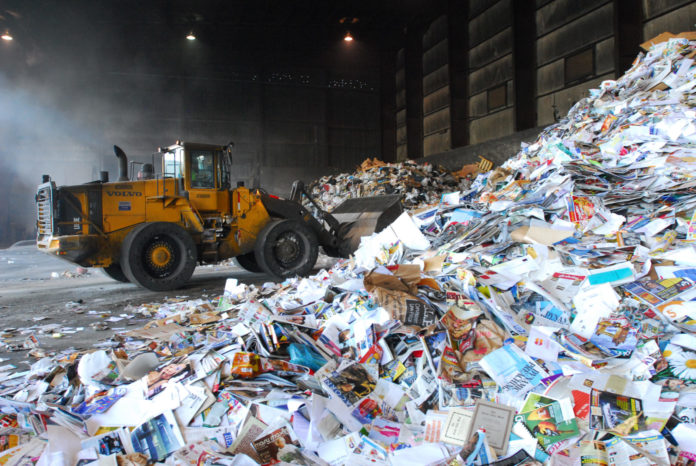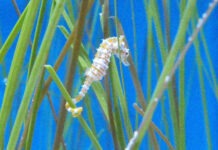Very few of us would consider it an ethical choice — whether to buy Corona beer in bottles or cans. The layperson shrugs a shoulder … both cans and bottles can be recycled, right? What does it matter? But it does. Right now, there is no secondary market for used glass in Florida. The one place that does take it charges for the service, according to Monroe County District Manager Greg Sullivan of Waste Management.
Sullivan said it’s cheaper to make new glass bottles rather than recycle old glass bottles. Aluminum cans, however, are a different story.
“Aluminum is one of the most valuable commodities, about $1,100 a ton,” he said.
Recycling is a market. Ten years ago, the market was better — less supply, more demand. Now, there are more recyclables entering the stream, but also more contamination — a greasy pizza box mixed in with reams of office paper, for example. And the global appetite for recycled materials has shifted considerably.
In 2017, the U.S. was sending 4,000 shipping containers full of recyclables A DAY to China — more than 50 percent of the world’s recycling market. But in 2018, China created a policy called “China’s National Sword.” It listed 24 types of waste it would no longer accept. Plus, it instituted a very low contamination rate of 0.5 percent, down from the 5 percent to 10 percent it used to accept.
“The global recycling market is challenged right now,” said Dawn McCormick, community affairs manager for Waste Management. “The little material that China will accept has to meet a standard of 0.5 percent contamination. But the material coming into our recycling centers can have rates as high as 30 percent contamination.”
Waste Management operates four MRFs (Materials Recovery Facility), or recycling centers, in Florida. There are another three or so that are operated by other companies. The waste from the Florida Keys heads to the Reuter Recycling Center in Pembroke Pines.
Sullivan said contamination is a huge problem for curbside recycling.
“Plastic bags are our biggest enemy. If a plastic bag gets into the recycling and enters the system it hurts all the equipment that does the sorting — conveyor belts, shafts, bearings — the plastic bag wraps around the machinery and destroys it,” Sullivan said.
Thirty percent to 40 percent of Florida’s recyclables are contaminated (a figure backed by the state Department of Environmental Protection). And only 35 percent of what is sorted has a positive market value, i.e. a secondary recycler will buy the tons of clean paper or empty plastic water bottles. What’s left goes into the landfill or is burned in a waste-to-energy plant.
“The otherside of the coin isn’t all bad,” Sullivan said. “Plastic burns great.”
Waste-to-energy processes generate electricity and/or heat directly through combustion, or produce a type of fuel such as methane, methanol, ethanol or synthetic fuel.
While recyclers in Florida and the Florida Keys are largely unfazed by the changes in the global market, other places in the country are not so fortunate. Various news outlets are reporting that Philadelphia is burning about 50 percent of its recyclables, leading to public health concerns.
The future of recycling isn’t in jeopardy, but the face of recycling is likely to change.
“We have contracts in place, so I don’t see any immediate changes. Our biggest push is to educate people,” Sullivan said. “If you’re not recycling properly, it’s just wasted effort, wasted time, everything is wasted. If three people recycle correctly, and the fourth doesn’t and contaminates the recyclables, everyone’s good efforts are lost.”
McCormick states it more plainly. “When in doubt, throw it out,” she said. This applies, she said, to dirty pizza boxes or peanut butter jars.
Sullivan wants the consumer to consider what can and can’t be recycled before buying. He likes plain old bar soap that comes in a thin paper wrapper, rather than a plastic bottle of liquid body soap. Choose aluminum cans over glass bottles. Buy in bulk — a big jug that can refill a counter-top dish soap dispenser.
“Think about what you’re buying and the implications of recycling it,” he said.
“Wish-cycling” — well-intentioned recycling that ends up creating more problems than solutions. While the intentions are good, these mistakes are costly and time-consuming — sometimes shutting down processing plants for hours at a time.” — floridarecycles.org
The shrinking recyclable market, and the need to recycle correctly, will make it difficult to meet the state mandate passed six years ago — increase recycling rates to 75 percent by 2020 in Florida. (Fortunately, putting solid waste through waste-to-energy processes will count towards this goal.)
One state legislator has put forth a 2019 bill that would address contamination. In HB 771, Palm City Republican Rep. Toby Overdorf wants local governments to create strategies for minimizing contamination, and create procedures by which the contaminated recycling could be rejected.
HB 771, put forward by Overdorf and the companion SB 816 advanced by Gainesville Republican Senator Keith Perry, are making progress in this legislative season.
“In other words, they aren’t contaminated so it allows for the waste companies to have more material going to recycling rather than the landfills,” Overdorf told the Tampa Bay Times.
The bill has passed several committee readings, including the House Agriculture and Natural Resources Subcommittee and Senate Environment and Natural Resources, with some amendments.
STICK TO THE BASICS
Recycle:
• Aluminum and steel cans
• Plastic bottles and jugs
• Clean paper and cardboard
Remember:
• Keep items clean and dry
• NEVER recycle plastic bags in curbside containers
• NEVER recycle Styrofoam trays or peanuts in curbside containers























